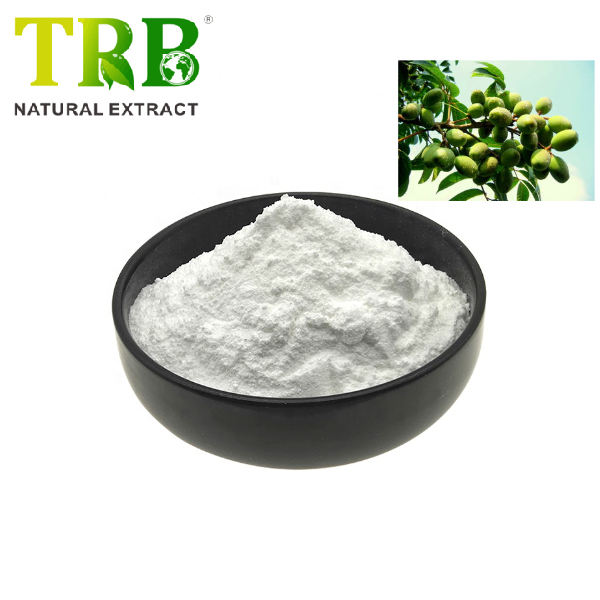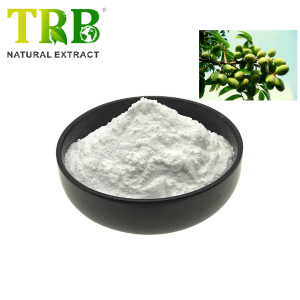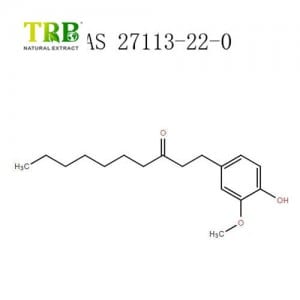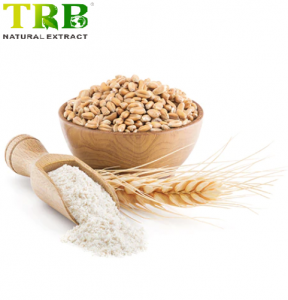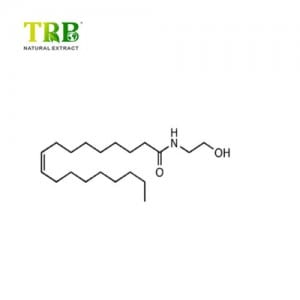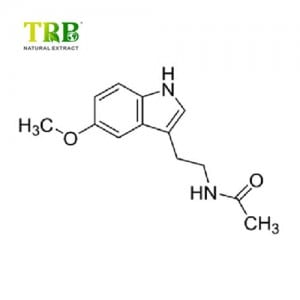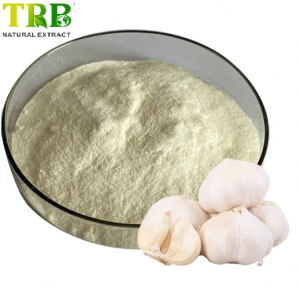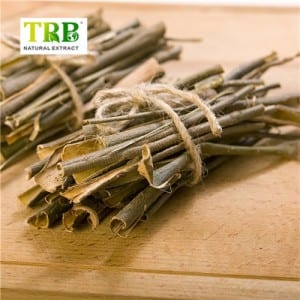Ácido oleanólico, que é um triterpenóide pentacíclico isolado de plantas Gentianaceae de Swertia mileensis, a grama inteira ou fruto de alfeneiro, com corpo livre e glicosídeos em muitas plantas.O ácido oleanólico tem uma ampla variedade nas plantas e o teor médio é de 0,2% a 2%.O alto teor de Cucurbitaceae é de 1,5% ~ corcunda inferior 2%, teor de frutos de alfeneiro de 0,6% ~ 0,7%. O ácido oleanólico é um tipo de composto triterpenóide pentacíclico isolado do fruto do gênero Asteraceae, Syzygium sylvestris ou Ligustrum lucidum.É um adjuvante para doenças hepáticas e é clinicamente utilizado para infecções terapêuticas.A hepatite icterícia aguda tem efeitos óbvios na redução da alanina aminotransferase e no amarelecimento. O ácido oólico é um triterpenóide pentacíclico isolado do fruto de swertia chinensis ou fructus ligustris da planta gentianaceae.O ácido oleanólico é amplamente encontrado em plantas, com um conteúdo geral de 0,2% ~ 2% [1].O conteúdo do fundo da cabaça foi de 1,5% ~ 2%, e o conteúdo do fruto de fructus ligustris foi de 0,6% ~ 0,7%.O ácido oleanólico é um cristal acicular branco (etanol), inodoro e insípido.Instável a ácidos e bases.Ponto de fusão de 308 ~ 310 ℃, [alfa] 20 d + 73,3 ° (c = 0,15, clorofórmio, insolúvel em água, solúvel em metanol, etanol, éter etílico, acetona e clorofórmio. O ácido oleanólico é um triterpenóide natural, amplamente distribuído em alimentos e plantas medicinais, relacionado ao ácido betulínico. Pode ser encontrado em Phytolacca americana (erva-da-índia americana) e Syzygium spp, alho, etc. É relativamente atóxico, hepatoprotetor e apresenta propriedades antitumorais e antivirais.
Descobriu-se que o ácido oleanólico exibe forte atividade anti-HIV, o composto relacionado ácido betulínico foi usado para criar o primeiro medicamento inibidor de maturação comercial.Foi estudado e isolado pela primeira vez de várias plantas, incluindo Rosa woodsii (folhas), Prosopis glandulosa (folhas e galhos), Phordendron juniperinum (planta inteira), Syzygium claviflorum (folhas), Hyptis capitata (planta inteira) e Ternstromia gymnanthera (aérea papel).Outras espécies de Syzygium, incluindo maçã java (Syzygium samarangense) e maçã rosa, contêm-no.
Nome do produto: ácido oleanólico98%
Especificação: 98% por HPLC
Fonte Botânica:Extrato de Olea Europea
Nome químico: ácido (3β) -3-hidroxioliano-12-en-28-óico
Nº CAS:508-02-1
Parte Utilizada: Folha
Cor: Pó branco com odor e sabor característicos
Status OGM: Livre de OGM
Embalagem: em tambores de fibra de 25kgs
Armazenamento: Mantenha o recipiente fechado em local fresco e seco, mantenha longe da luz forte
Prazo de validade: 24 meses a partir da data de produção
O que éácido oleanólico?
Ácido oleanólico (OA), um ácido triterpenóide hidroxila pentacíclico natural (HPTA) semelhante ao ácido betulínico, ácido ursólico;tem benefícios como atividades antibacterianas, antiinflamatórias e antitumorais.

Onde você pode encontrarácido oleanólico?
O ácido oleanólico tem sido usado tradicionalmente para o tratamento de diversas doenças, podendo ser encontrado amplamente em alimentos e plantas.
Algumas frutas como maçã, romã, limão, mirtilo e azeitona também contêm ácido oleanólico.

| Nome da Erva | Conteúdo de ácido oleanólico | Método de teste |
| Ligustrum lucidum Ait | 0,8028% | HPLC |
| Verbena Officinalis L | 0,071%-0,086% | HPLC |
| Prunella vulgaris L | 3,47%-4,46% | HPLC |
| Hemsley Chinensis Cog. | 1,5%~2% | HPLC |
Atualmente, a erva chinesaHemsley Chinensis Cognainda é a matéria-prima mais comercial para a extração do ácido oleanólico.
Hemsley Chinensis Cog.Introdução
Hemsleya chinensis Cogn.é uma erva trepadeira perene, também é medicina tradicional chinesa.
Família: Cucurbitáceas
Tribus: Gomphogyneae
Gênero: Hemsleya
Espécie: H. amabilis
A erva é distribuída nas províncias de Guangxi, Sichuan, Guizhou, Yunnan, Hubei, etc. Nasce na borda da floresta e nos arbustos do vale a uma altitude de cerca de 2.000 metros.
Ingredientes ativos: contém Hemslolide Mal、Ma3、H1;Chikusetsusaponina-Iva;dihidro cucurbitacina F-25-acetato;dilidrocucurbitacina F;ácido oleanólico-beta-Hlucosiloleanolato;Hemsamabilinina A;Cu-curbitacinaⅡb-2-beta-D-glucopiranosídeo.
Valores Medicinais:
Hemsleya chinensis Cogn.serve principalmente para desintoxicação, esterilização, antiinflamatório, fortalecimento do estômago e alívio de dores.Atualmente, existem extratos em pó, ou preparações compostas como cápsulas, comprimidos, pílulas gastrointestinais, etc., que são amplamente utilizados na prática clínica.

Extração de ácido oleanólico deHemsleya Chinensis Cogn.

Fórmulas contendo ácido oleanólico em suplementos alimentares
Descobrimos que o ácido oleanólico usado em suplementos de saúde vem principalmente de três tipos de extratos de plantas: extrato de folhas de nêspera, extrato de Hemsley Chinensis e extrato de manjericão sagrado.
- Pó de manjericão sagrado (folha) (0,4% de ácido ursólico e ácido oleanólico, 2,0 mg)
- Extrato supercrítico de CO2 de manjericão sagrado (folha) (Ocimum tenuiflorum Linn.) (2,5% de ácido ursólico e ácido oleanólico, 1,5 mg)
- Extrato de nêspera (fruta) (fornecendo ácido ursólico, ácido oleanólico) (padronizado para ácido ursólico por porção de 125 mg)

Ácido oleanólico VS ácido ursólico
O ácido oleanólico (OA) e o ácido ursólico (UA) são triterpenóides naturais que possuem uma estrutura química semelhante.
Sabe-se que esses compostos triterpenóides existem em ervas medicinais e alimentos.
Eles têm muitas propriedades farmacológicas comuns: atividades hepatoprotetoras, antiinflamatórias, antimicrobianas, hipoglicêmicas, antimutagênicas, anti-HIV, antioxidantes e antifertilidade.

Diferença entre OA e UA:
| Nome do Produto | Ácido oleanólico | Ácido ursólico |
| Nº CAS. | 508-02-1 | 77-52-1 |
| Triterpenos pentacíclicos | β-amirina | α-amirina |
| Fontes de ervas | Folha de nêspera, manjericão sagrado, alecrim, folha de oliveira.etc. | |
| Especificações | 40%,98% de pó | 15%,25%,50%,98%pó |
| Aparência (cor e odor) | 40% amarelo claro98% pó branco inodoro | 15%-50% marrom-amarelo ou amarelo98% pó brancoCaracterística |
| Distintivo | IR:(1355~1392cm-1) dois picos(1245~1330cm-1) três picosNMR:δ(C12)122,1,δ(C13)143,4 | (1355~1392cm-1) três picos (1245 ~ 1330 cm-1) três picosδ(C12)125,5,δ(C13)138,0 |
| Derivados | Sal de sódio oleanólicoFosfato de ácido oleanólico sal dissódicoÁcido 3-oxo oleanólico bardoxolona metil (CDDO-Me) | Sal de sódio ursólico e seus derivados de meio éster de ácido dicarboxílico Derivados de ceteno de ácido ursólicoÁcido ursólico de 3 carbonos ácido 3-acetoxiursólico |
| Potencial anticâncer | UA é mais popular que OA. | |
Atividades Biológicas do Ácido Oleanólico
-
Efeitos antitumorais/anticancerígenos
Efeito inibitório do ácido oleanólico no carcinoma hepatocelular via parada do ciclo celular mediada por ERK-p53 e apoptose dependente de mitocôndria
– por Xin Wang, Hua Bai, etc. Pesquisadores
A OA exibiu um efeito inibitório sobre o CHC através da indução de apoptose e paragem do ciclo celular tanto em tumores transplantados como em células HepG2.
A OA induziu apoptose através da via mitocondrial, evidenciada pela inibição da via Akt/alvo mamífero da rapamicina.
A OA induziu a parada do ciclo celular G2 / M através da regulação negativa da ciclina B1 / cdc2 mediada por p21.
A OA demonstrou atividades antitumorais significativas em modelos in vivo e in vitro de CHC.Estes dados fornecem uma nova visão sobre os mecanismos subjacentes ao efeito antitumoral da OA.
Além disso, pesquisas mostram que o OA e seu derivado éster metílico do ácido oleanólico também têm efeitos no câncer de mama, câncer de pulmão, câncer de bexiga, câncer cervical, células cancerosas pancreáticas…

-
Actividade antimicrobiana
Espera-se que a OA possua atividade antimicrobiana contra uma ampla gama de patógenos, pois desempenha um papel vital na defesa contra patógenos em plantas.
OA apresentou atividade moderada contra Staphylococcus aureus e Bacillus Thuringiensis a 62,5 µg/mL e Escherichia coli, Salmonella Enterica e Shigella dysenteriae a 31,2 µg/mL de concentração inibitória mínima (CIM).
-
Capacidade Hepatoprotetora
Uma das bioatividades notáveis da OA é a proteção do fígado contra toxicidade e atualmente está sendo usada como medicamento hepático de venda livre na China.
Em ratos albinos Wistar, foi utilizado OA de Flaveria Trinervia e teve um efeito protetor significativo na toxicidade hepática induzida pelo etanol, restaurando os níveis de enzimas marcadores séricos hepatotóxicos.Este estudo sugeriu a capacidade antioxidante da OA como outro possível mecanismo de sua capacidade hepatoprotetora.
Ácido Oleanólico e seus derivados

Ensaios clínicos de ácido oleanólico
O ácido oleanólico (proveniente da azeitona), existem cerca de 500 ensaios clínicos registrados, mostrou ter efeitos benéficos em ensaios clínicos sobre doenças renais crônicas, diabetes mellitus tipo 2 e algumas condições inflamatórias, como artrite.
Os derivados mais populares em ensaios clínicos são a bardoxolona metil (CDDO-Me).O CDDO-Me foi avaliado em biópsias tumorais e pode desempenhar um papel no tratamento da doença renal crônica; atualmente está sendo avaliado quanto aos efeitos sobre a hipertensão.
Padrão da Farmacopeia Chinesa de Ácido Oleanólico
| Nome do Produto | Ácido Oleanólico |
| Identificação | (1)Pegue 30mg deste produto, coloque em um tubo de ensaio, adicione 3ml de clorofórmio para dissolver, adicione duas gotas de ácido sulfúrico, agite por 5 minutos, a camada de clorofórmio é vermelho-púrpura. |
| (2)Pegue cerca de 20mg deste produto, adicione 1ml de anidrido acético, dissolva com um leve calor, adicione ácido sulfúrico até a cor roxa e escureça após a colocação. | |
| (3) Pegue cerca de 10mg deste produto, adicione solução de ácido acético glacial de vanilina (tome vanilina 0,5g, adicione 10ml de ácido acético glacial para dissolver, ou seja) 0,2ml, adicione 0,8ml de ácido perclórico e aqueça por vários minutos em banho-maria.Fúcsia, adicionar 2ml de acetato de etila, vermelho-púrpura dissolvido em acetato de etila, colocado sem descoloração. | |
| (4) O espectro de absorção infravermelha deste produto deve ser consistente com o espectro de controle. | |
| Determinação do ensaio | Pegue 0,15g deste produto, pese com precisão, adicione 30ml de etanol, agite, aqueça em banho-maria para dissolver, deixe esfriar até a temperatura ambiente, adicione 3 gotas de solução indicadora de fenolftaleína, faça solução de hidróxido de potássio com etanol ( 0,05mol/L) Titular imediatamente e corrigir para teste em branco.Solução de hidróxido de potássio (0,05 mol/L) por 1 ml de etanol corresponde a 22,84 mg de C30H48O3. |
Ácido oleanólico recomenda dosagem
De acordo com o Padrão da Farmacopeia Chinesa, a dose oral de ácido oleanólico é de 20 ~ 80 mg por vez, 60 ~ 240 mg por dia.
Efeitos colaterais do ácido oleanólico
Ácido oleanólico usado como medicamento hepatoprotetor de venda livre (OTC) há décadas na China.
Em caso de sobredosagem ou incorreta, um pequeno número de pacientes apresenta boca seca, diarreia, desconforto abdominal superior e pode desaparecer após tratamento sintomático.
Consulte seu médico ou farmacêutico antes de usar este produto.
Função:
1. O ácido oleanólico é relativamente não tóxico, antitumoral e hepatoprotetor, além de exibir propriedades antivirais.
2. Descobriu-se que o ácido oleanólico exibe forte atividade anti-HIV.
3. O ácido oleanólico é um importante protetor das células contra o estresse oxidativo e eletrófilo.
4. O ácido oleanólico tem grande efeito no tratamento da hepatite viral, hepatite ictérica aguda e hepatite crônica.
Aplicativo:
1. Aplicado na área alimentícia, pode atuar como matéria-prima do chá para reduzir o catarro;
2. Aplicado na área farmacêutica, torna-se um novo medicamento anticâncer com baixa toxicidade;
3. Aplicado na área cosmética, pode revigorar a circulação sanguínea e remover bebidas.
| Mais informações sobre TRB | ||
| Certificação regulamentar | ||
| Certificados ISO USFDA,CEP,KOSHER HALAL GMP | ||
| Qualidade confiável | ||
| Quase 20 anos, exporta 40 países e regiões, mais de 2.000 lotes produzidos pela TRB não apresentam problemas de qualidade, processo de purificação exclusivo, controle de impurezas e pureza atendem USP, EP e CP | ||
| Sistema de Qualidade Abrangente | ||
|
| ▲ Sistema de garantia de qualidade | √ |
| ▲ Controle de documentos | √ | |
| ▲ Sistema de validação | √ | |
| ▲ Sistema de treinamento | √ | |
| ▲ Protocolo de Auditoria Interna | √ | |
| ▲ Sistema de auditoria de fornecedor | √ | |
| ▲ Sistema de instalações de equipamentos | √ | |
| ▲ Sistema de controle de materiais | √ | |
| ▲ Sistema de Controle de Produção | √ | |
| ▲ Sistema de etiquetagem de embalagens | √ | |
| ▲ Sistema de Controle de Laboratório | √ | |
| ▲ Sistema de validação de verificação | √ | |
| ▲ Sistema de Assuntos Regulatórios | √ | |
| Controle fontes e processos inteiros | ||
| Controlou rigorosamente todas as matérias-primas, acessórios e materiais de embalagem. Fornecedor preferido de matérias-primas e acessórios e materiais de embalagem com número DMF dos EUA. | ||
| Instituições Cooperativas Fortes para apoiar | ||
| Instituto de Botânica/Instituição de Microbiologia/Academia de Ciência e Tecnologia/Universidade | ||
